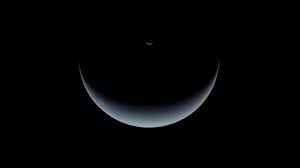Among Neptune’s 14 moons, Triton stands out as the largest. What makes it truly remarkable is its unconventional behaviour – it is the only moon in our solar system that orbits in a direction opposite to its planet’s rotation. According to scientists, Triton is believed to be a celestial body that originally belonged to the Kuiper Belt — a region of space beyond Neptune. NASA says that there is a possibility that it may have been captured by Neptune’s gravitational pull millions of years ago. Interestingly, Triton shares numerous similarities with Pluto, which is the most prominent representative of the Kuiper Belt.
Today’s NASA Astronomy Picture of the Day is a crescent phase Neptune with its moon Triton. In 1989, as the Voyager 2 spacecraft gracefully journeyed through the outer reaches of the Solar System, it turned its gaze towards the Sun and captured a captivating sight: a crescent phase of the most distant planet, Neptune, accompanied by its moon Triton.

More about Neptune with its moon

This remarkable image of an icy giant planet and its largest satellite was taken from a unique perspective, positioned behind them, shortly after Voyager’s closest encounter. This NASA photo of the day could not have been captured from Earth since the most distant planet never shows itself in a crescent phase when viewed from a sunward perspective. As the spacecraft zoomed towards the heliopause, its departing position offered a fresh vantage point that ᵴtriƥped Neptune of its famous blue hue.
Triton – the largest moon of Neptune

Triton was first discovered by William Lassell on October 10, 1846, just 17 days after Neptune was spotted by an observatory in Berlin. Since then, scientists have used advanced telescopes and spacecraft to find a total of 14 moons orbiting this distant icy planet. Triton itself has a size of about 1680 miles (2700 kilometers) in diameter.
Interestingly, Triton has a density that is roughly double that of water. This means it is denser than most other moons around the outer planets, NASA explained. This suggests that Triton has more rocky material inside it compared to the icy moons around Saturn and Uranus.





